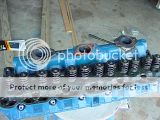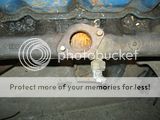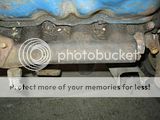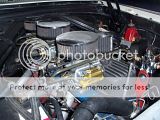I could have posted this in the Harcore Section, but its been pretty quiet there, and in any case, I'm sure no-one will mind the summary of a 32 year quest on carbuation venturi area verses horsepower. It makes a fun read if your interested, and can also drive you to sleep if your unable to turn in without being wired!
I've been working through the dynamics of all small block I6 log induction systems, 1-bbl, 2-bbl, 4-bbl, dual 1-bbl and 2-bbl, 3 x 1-bbl, 3 x 2-bbl, port EFI, 1-bbl TBI, 2 bbl TBI.
The intake runner volumes, the valves, the port areas, the action of differernt exhasts and dual pattern cams.
I prepared a calibration model, Restrictor Plates 27_11_2011.jpg, and used it to develop my NCHO-6V intake, the NCHO-2V intake and now the NCHO-4V intake.
It's based on the power curve verses carb venturi area, not carb throttle area. The factor to look at is "Cubic inches per sq in of carb venturi" in column T
Here are some screen dumps.




A really restricted engine will have 1 sq in of carb area to 300 cubic inches of engine. Example was the old Ford Zephyr 155 cubic inch six as used in the 1961 AC Ace in line 86. That is more restricted than a WRC or Restrictor plate equiped NASCAR.
The WRC, a two liter turbo engine, has a 35 mm plate giving 81.8 cubic inches per square inch of induction. The old Winston Cup NASCARS were running 127 to 146.
The NASCAR restrictor plate engines are
less restricted than any stock 1-bbl Falcon Six engined Ford.
A really unrestricted engine is the Lamborghini LP 400, with about 11 cubic inches of engine per sqaure inch of carb.
A triple carbed 250 with 1904 Holleys is on the lower end of restriction, but still as restricted as a WRC rallye car. And more restricted than a 1970 Pinto 2000 with a 5200 Holley Weber 2-bbl. (71 cubes per square).
The European 88 hp 1600 GT Pinto engine (97 cubes for 88 pintos, um, ponies) had less cubes per square inch of venturi than a 351 4V Boss/Phase iii engine (57 vs 59). In terms of specific out put, the production lines hotest Cleveland still made more gross or net power per cube. (Rated at 330 hp, but known to give 350 hp net, and 380 hp gross)
I've found that the secrete to getting power from the Log I6 was actually sorted in 1961 by Raymond Mays and Ken Rudd on the little Ford Zephyr six. That was a four bearing I6 which had an iron head which had trouble making 125 hp with a good set of triple SU's. After remaking it in alloy, triple SU verions were making 168 hp in competition trim, and 170 hp in Triple DCOE 40 form.
That design was then copied by a raft of people in Australia , with all alloy heads being made for other non Ford, non crossflow I6's and v8's. Yes, a non cross flow V8, giving more power than a cross flow one.
First, by the famous Phil Irving in 1976, and out came the Phil Irving HP 12 non cross flow Holden 202 cylinder head, all in alloy. About the same time, Frank Duggan made also made a RM/KR knock off for 202 GM Holden and 250/292 GMC/Chev L6's.
Each was an RM/KR rip off, with high port heads and very special intake shapes.
After realising that independent runners made the power back in 2003, the key came through Bill in Indy's posts in the Big Six section in 2008...the idependent runner was a 25% boost in power over any other combination, apples verses apples.
I then found out that its not port shape or hogging out the short turn radius, but flow effeciency and the right carb venturi and carb throttle area that helps make power.
The key is that the hand made log multiple carb conversions are always better than the stock commercial versions, because of the carb area issue. The nicest versions of the Raymond Mays and Ken Rudd head are here



The key is that the intake is just a basic adaptor to mount the carbs to the head. And the mutiple carb log head can get very close to the Classic Inlines head for flow rate.
And 370hp at 7500 rpm is common with just a set of DCO Webers from about 200 cubes.
So lets see,
170 hp from triple DCOE 40'S 156 cubes,
220 hp 250 3 x 1-bbl.
and 370 hp at 7500 rpm with 202 cubes with 3 DCO 48'S (As good as the Prep H 300 with triple IDA 48's in the big block section, at the same revs, from a third the engine size

).
390 hp at 9500 rpm with 181 cubes and 48 IDA 2-bbl,
The right log intake conversion will liberate a lot more power than just 220 hp, impressive though that is.
To me, its all a bit like feeding the mutitudes. The less bread and loaves, the greater the amount of left overs. If a NASCAR can suck 650 hp at 7500 rpm through just 6.49 sq inches of carb at the gasket face with a 355, then surely 325 hp at 7500 rpm from 3.19 sq in and 178 cubes is possible.
And if its possible to get 354 hp at 6700 rpm from a 289 with a 4.47 sq in 4412 500 cfm 2-bbl, it should follow a halfway house would be an I6 with 233 cubic inch engine with about 3.83 sq in of Tri-power carb throttle area should hack 340 hp at about 7000 rpm.
That's the point I'm making...to eek out more power with a less radical engine combination is proof of a good cam and carburation package. At the moment, the Tripower is the odd man out, and it just shouldn't be.
































